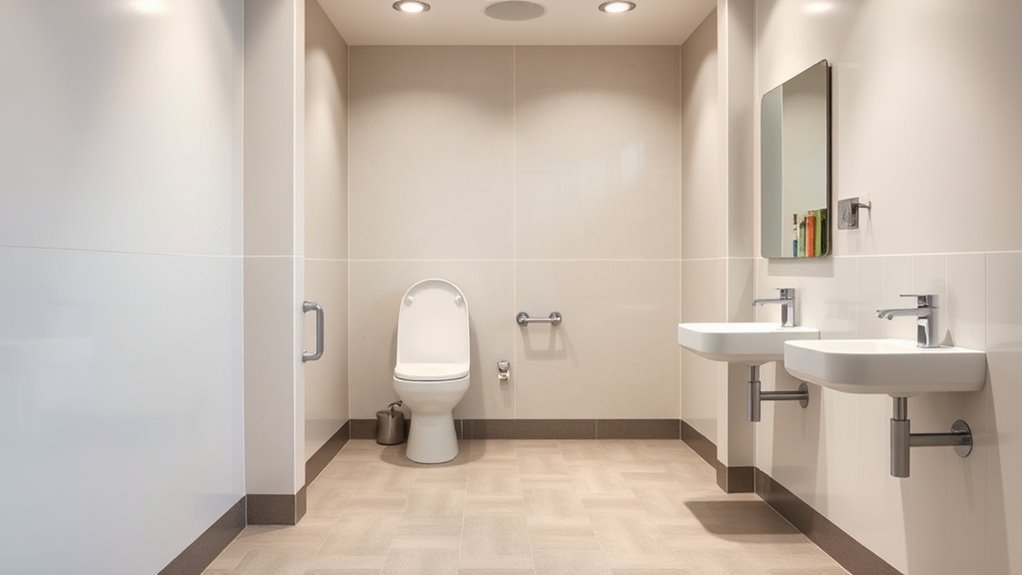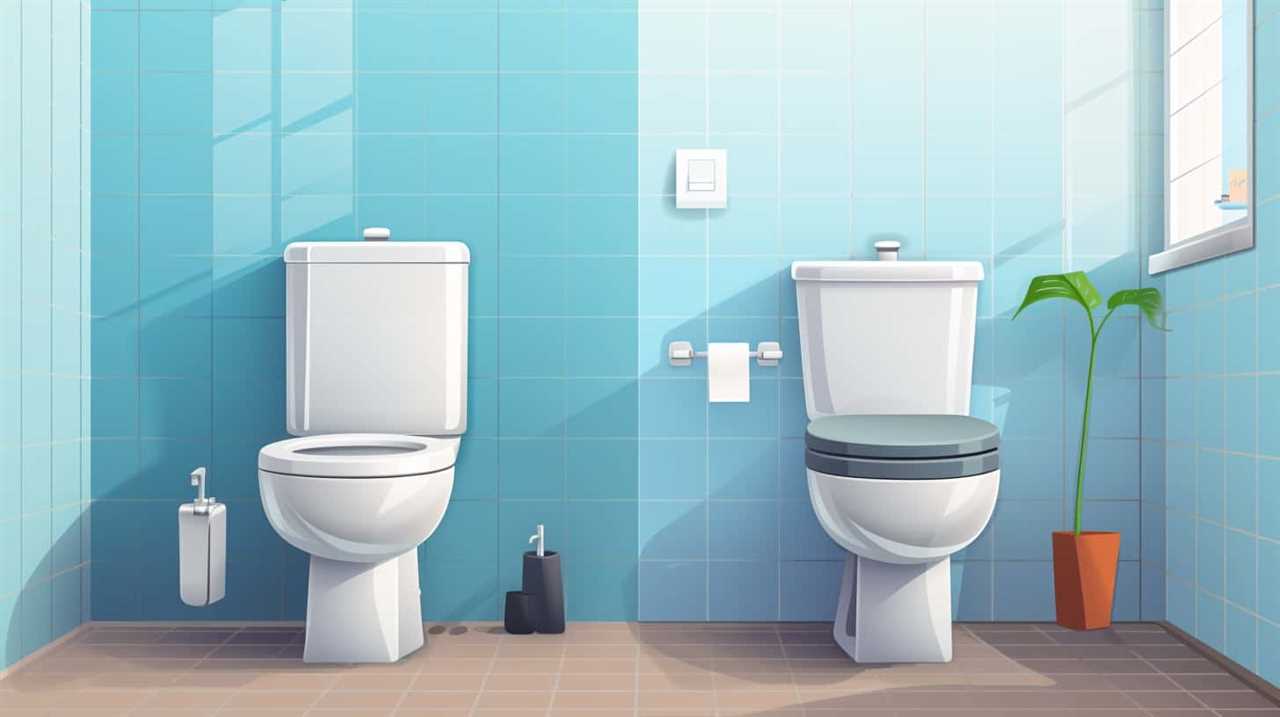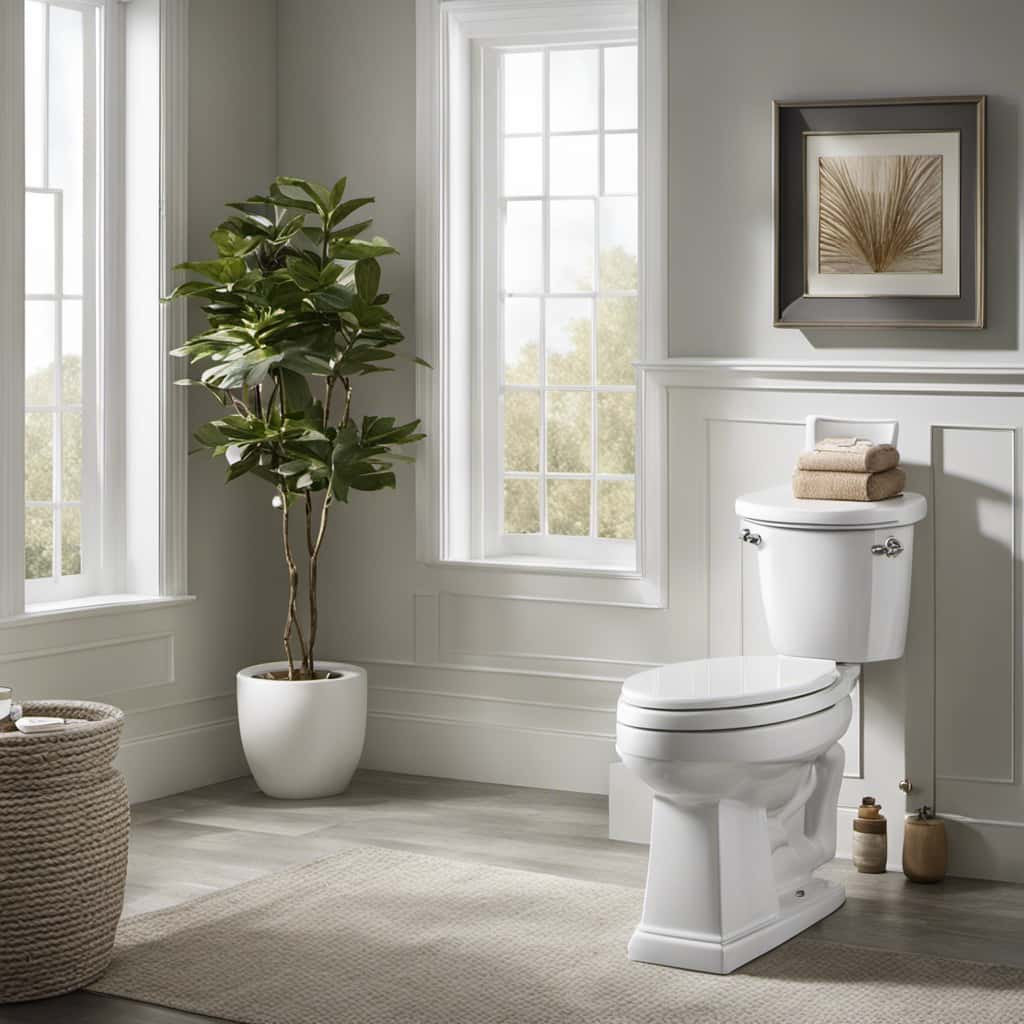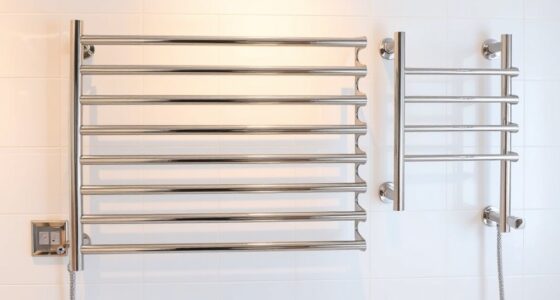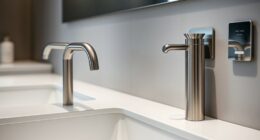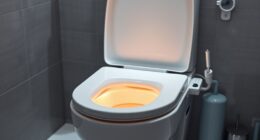When choosing an accessible toilet, focus on features that boost comfort and safety, like a ADA-compliant height, sturdy grab bars, and non-slip flooring. Guarantee there’s enough space around the toilet for easy maneuvering and transfers, especially if you or someone else might need assistance. Proper lighting and thoughtful layout prevent accidents and make daily routines smoother. To create a bathroom that truly supports independence, keep these essentials in mind—you’ll find more helpful tips ahead.
Key Takeaways
- Choose comfort height or ADA-compliant toilets for easier sitting and standing.
- Install grab bars and non-slip flooring to enhance safety and stability.
- Ensure sufficient space around the toilet for maneuvering and caregiver assistance.
- Opt for easy-to-use features like lever-style or touchless flush systems.
- Prioritize proper lighting and thoughtful layout to improve visibility and accessibility.

Have you ever struggled to find a clean, private toilet that accommodates your needs? If so, you’re not alone. Accessibility is an essential aspect of bathroom design, especially when it comes to ensuring comfort and safety for everyone, including the elderly or those with mobility challenges. When selecting accessible toilets, it’s essential to consider how the bathroom layout influences ease of use and safety. A well-thought-out bathroom design can make a significant difference, reducing the risk of falls and making daily routines less stressful. For elderly assistance, the right toilet setup isn’t just about convenience—it’s about enabling independence and dignity.
Accessible bathroom design promotes safety, independence, and dignity for everyone.
Start by thinking about the space available. An accessible toilet should have enough room around it to allow for easy maneuvering, especially if a wheelchair or walker is involved. This often means opting for models that are higher than standard, known as comfort height or ADA-compliant toilets. These toilets help users sit down and stand up more easily, reducing strain on knees and hips. Additionally, consider installing grab bars nearby. These sturdy handrails provide essential support, helping elderly users maintain balance and stability while sitting or standing. When integrated into bathroom design, grab bars can transform an ordinary space into a safe haven, giving users confidence and independence.
Another essential factor is the toilet’s flushing mechanism. Choose models with easy-to-use, lever-style flushes or touchless options that require minimal effort. For elderly assistance, such features are particularly helpful, as they eliminate the need for excessive force or complex maneuvers. Complementing this is ensuring the entire bathroom is equipped with non-slip flooring and adequate lighting, which further minimizes accident risks. Good bathroom design incorporates these safety features seamlessly, so that the environment promotes confidence rather than caution.
When considering accessible toilets, you should also think about privacy and convenience. A well-designed bathroom layout incorporates enough space for caregivers to assist without feeling cramped. This is especially important for elderly or disabled users who may need help with transfers or hygiene routines. Placing the toilet in a position that’s easy to access from the entrance, with enough clearance for a caregiver to assist, makes a big difference in daily comfort and safety. Incorporating proper space planning ensures that the bathroom remains functional and secure for all users.
Frequently Asked Questions
Are Accessible Toilets Suitable for Children?
Accessible toilets can be suitable for children if they include family-friendly features like lower heights and safety rails, ensuring child safety and ease of use. These features make the toilet more convenient for kids and help parents supervise and assist comfortably. Always check for adjustable elements and secure grab bars, so your child feels safe and confident using the toilet. It’s about creating a space that’s practical and safe for the whole family.
How Do I Maintain an Accessible Toilet?
Did you know that proper cleaning maintenance can extend your toilet’s lifespan by up to 50%? To keep your accessible toilet in top shape, regularly clean it with mild disinfectants, paying attention to safety features like grab bars and flush mechanisms. Check for leaks, tighten bolts if needed, and replace worn parts promptly. This guarantees safety, hygiene, and reliable performance for everyone who uses it.
Can Accessible Toilets Be Installed Outdoors?
Yes, you can install accessible toilets outdoors, but you need to take into account weather resistance and proper outdoor installation. Choose models specifically designed for outdoor use, with durable, weather-resistant materials that can withstand rain, sun, and temperature changes. make sure you have appropriate drainage and protection from the elements. Proper installation is key to maintaining safety and functionality, so consult a professional to ensure compliance and durability for outdoor accessible toilets.
What Are the Costs of Installing Accessible Toilets?
Did you know that the average cost of installing an accessible toilet ranges from $1,500 to $5,000? You’ll find a wide cost comparison depending on your needs and location. Installation challenges, like plumbing adjustments and space requirements, can influence price. Budgeting for these factors ensures you’re prepared for a smooth process. Overall, investing in accessible toilets enhances safety and comfort, making it well worth the expense.
Are There Portable Accessible Toilet Options?
Yes, portable accessible toilet options are available. These solutions are ideal for events, construction sites, or emergency readiness situations, offering convenience and mobility. Portable solutions guarantee you can provide comfort and safety wherever needed, without permanent installation. They’re easy to set up and maintain, making them a practical choice for temporary needs. If you require flexibility, portable accessible toilets are a reliable, user-friendly option to contemplate.
Conclusion
Choosing the right accessible toilet isn’t just about comfort—it’s about ensuring safety when it matters most. Imagine stepping into your bathroom, knowing you’ve made the perfect choice that provides security and peace of mind. But what if the next visit brings unexpected challenges? By understanding your options now, you’ll be prepared for anything. The right accessible toilet can transform your daily routine—are you ready to make that vital decision today?
